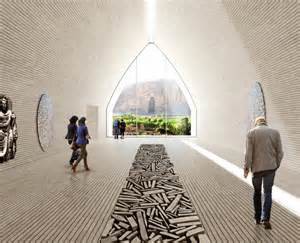 As reported by a number of news outlets, a proposal to carve a cultural centre out of the landscape has won the UNESCO design contest for a Bamiyan Valley site where two seventh-century statues of Buddha were destroyed by Taliban militants. Out of many applicants and design presentations, UNESCO picked and has now named an Argentina-based team led by architect Carlos Nahuel Recabarren as the winner of the competition. UNESCO had asked entrants to design a building for the edge of a valley in the central highlands of Afghanistan – a key Buddhist site on the ancient Silk Road trading route.
As reported by a number of news outlets, a proposal to carve a cultural centre out of the landscape has won the UNESCO design contest for a Bamiyan Valley site where two seventh-century statues of Buddha were destroyed by Taliban militants. Out of many applicants and design presentations, UNESCO picked and has now named an Argentina-based team led by architect Carlos Nahuel Recabarren as the winner of the competition. UNESCO had asked entrants to design a building for the edge of a valley in the central highlands of Afghanistan – a key Buddhist site on the ancient Silk Road trading route.
The winning proposal which is named “Descriptive Memory” presents the concept of “The Eternal Presence of Absence” and aims to envision a public park that extends out to meet the rooftops of a sunken building complex. These structures will surround a public plaza with a reflective pool on one side. The winning team has stated their design thinking in a statement that reads; “Our proposal tries to create not an object-building but rather a meeting place; a system of negative spaces where the impressive landscape of the Buddha Cliffs intertwine with the rich cultural activity that the centre will foster”.
It has been reported that the foothills of the cliffs along the valley feature several caves dating from between the third and fifth century, which were used as Buddhist monasteries, chapels and sanctuaries. The cliffs themselves once housed two giant seventh-century carvings of Buddha, standing at 55 meters and 35 meters high, but these were destroyed by Taliban forces in 2001.
Following an intervention to prevent an unauthorized team of German archaeologists from reconstructing the statues, UNESCO teamed up with the Afghan government’s Ministry of Information and Culture to launch a competition for a new building on the site at the end of 2014. Then, the winning design was anonymously selected from 1,070 proposals by a jury of seven experts, including Architecture for Humanity co-founder Cameron Sinclair and the Cooper Union’s acting dean Elizabeth O’Donnell. The jury praised the concept for its well-conceived plan, sensitive site strategy, and choice of brick as building material, elegant curving passageways, and appropriate consideration of scale. The financial support has been contributed by the Republic of Korea and the project will immediately move towards construction on a budget of $2.5 million. In addition to the activities surrounding the building of this site, the Afghan government plans to launch a national program to support cultural diversity, which will include a nationwide archaeological survey and targeted activities to safeguard minority rights across the country.















